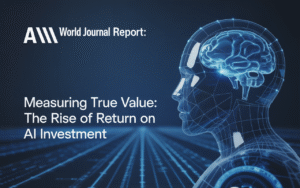https://theworldfinancialforum.com/participate/
AI WORLD JOURNAL NEWS WIRE


Measuring Beyond traditional ROI, ROAI captures productivity gains, cost savings, and competitive advantage to assess the real-world impact of AI initiatives.
Artificial Intelligence has become one of the most dynamic and capital-intensive industries in the world. From large language models (LLMs) to healthcare AI, valuations vary dramatically depending on growth prospects, adoption, and competitive pressures. By mid-2025, several clear patterns have emerged across AI subsectors, shaped by global investment flows, government incentives, and competitive races among the world’s largest technology firms.
Return on AI Investment (ROAI) has become a vital metric for assessing the true value of artificial intelligence deployments. Unlike traditional ROI, which focuses narrowly on financial gain, ROAI captures the broader benefits of AI adoption—including productivity improvements, cost reductions, risk mitigation, and competitive advantage.
In the early days of artificial intelligence, success was measured by technological milestones: beating humans at chess, powering voice assistants, or automating routine tasks. But as AI matured into a cornerstone of global business, the real question shifted from “Can it be done?” to “Is it worth it?”. By 2025, that question has crystallized into a new performance metric: Return on AI Investment (ROAI).
Why ROAI Is Emerging Now
For decades, organizations used ROI to gauge the profitability of initiatives. But AI is not like other technologies. Its impact is multifaceted, often spanning efficiency, decision-making, customer experience, and innovation. Traditional ROI calculations fail to capture these dimensions.
In 2025, with trillions pouring into AI—from generative AI models like ChatGPT and Gemini to robotics, healthcare algorithms, and AI-driven finance—business leaders need a framework that measures not just cost savings, but true value creation. That’s where ROAI comes in.
Defining ROAI
Return on AI Investment (ROAI) measures the tangible and intangible value an organization gains from its AI initiatives relative to the resources invested. Unlike traditional ROI, ROAI accounts for:
Operational Efficiency Gains – Reduced costs, streamlined workflows, and automation.
Revenue Growth – AI-powered product innovations, upselling, and new market opportunities.
Risk Mitigation – Better fraud detection, compliance management, and predictive maintenance.
Customer Experience Enhancements – Personalization, faster service, and improved satisfaction.
Strategic Differentiation – Competitive advantages that position a company as a leader.
In other words, ROAI goes beyond immediate financial returns to assess how AI strengthens long-term business resilience.
ROAI Across AI Sectors in 2025
Different sectors are approaching ROAI in unique ways, reflecting both the opportunities and challenges of AI adoption.
1. Healthcare
Hospitals and biotech firms are using AI for diagnostics, drug discovery, and patient care optimization. Here, ROAI isn’t just financial—it’s measured in lives saved, reduced error rates, and faster treatment delivery. By 2025, insurers and governments are also factoring ROAI into reimbursement models for AI-driven medical solutions.
2. Finance
Banks and fintech firms use AI for fraud detection, credit scoring, and algorithmic trading. ROAI is measured by reduced fraud losses, improved risk management, and increased transaction volume. AI has shifted from back-office support to a frontline profit driver.
3. Manufacturing & Supply Chain
AI-powered robotics, predictive maintenance, and demand forecasting deliver massive efficiency gains. Companies are calculating ROAI by looking at downtime reduction, optimized logistics, and carbon footprint improvements, aligning with sustainability goals.
4. Retail & E-Commerce
Recommendation engines, inventory optimization, and AI-driven customer support directly impact sales. ROAI is tracked through higher conversion rates, lower returns, and enhanced loyalty. In this sector, AI’s ability to personalize at scale has become a critical survival factor.
5. Media & Creativity
Generative AI in content creation, design, and video production has reshaped creative industries. Here, ROAI is evaluated not only in terms of cost savings but also in time-to-market acceleration and creative output expansion.
Challenges in Measuring ROAI
Despite its importance, measuring ROAI is far from straightforward:
Attribution Complexity: Separating AI’s contribution from other business drivers can be difficult.
Intangible Benefits: Improved decision-making or brand reputation are harder to quantify.
Rapid Technological Shifts: AI evolves so quickly that long-term valuations may become outdated within months.
Ethical Considerations: Negative externalities, like bias or job displacement, complicate the equation.
Organizations in 2025 are developing hybrid frameworks—blending financial metrics with KPIs for social impact, sustainability, and innovation.

The Road Ahead
ROAI is no longer just a boardroom buzzword; it’s becoming a standard lens for investment decisions. Investors are demanding ROAI metrics before funding AI startups. Enterprises are benchmarking against industry peers. Governments are considering ROAI in public-sector deployments, ensuring taxpayer money delivers measurable outcomes.
As AI becomes as critical as electricity or the internet, measuring its true value is essential. The companies that master ROAI in 2025 won’t just survive—they’ll lead. Those that ignore it risk sinking billions into projects that look impressive but fail to move the needle.
Conclusion
The rise of Return on AI Investment signals a maturing AI economy. In 2025, the winners aren’t those deploying AI for hype, but those proving its worth. ROAI reframes the conversation from “What can AI do?” to “What should AI do, and how much value does it create?”.
In an era where every dollar counts and every algorithm has consequences, ROAI may just be the north star guiding AI’s sustainable future.
The post Measuring True Value: The Rise of Return on AI Investment (ROAI) Valuation Across AI Sectors in 2025 appeared first on AI World Journal.